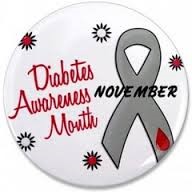November is National Diabetes Month. Each week this month, we will be posting about a different topic related to Diabetes.
Did you know…
- Nearly 30 million children and adults in the United States have diabetes
- Another 86 million Americans have prediabetes and are at risk for developing type 2 diabetes
- The American Diabetes Association estimates that the total national cost of diagnosed diabetes in the United States is $245 billion
Let’s start with some basic definitions
Diabetes mellitus: a condition characterized by high blood sugar levels resulting from the body’s inability to use blood glucose for energy. Glucose is the energy source of cells that make up your muscles and tissues.
Type 1 diabetes: in Type 1 diabetes the pancreas no longer makes insulin and therefore blood glucose cannot enter the cells to be used for energy.
Type 2 diabetes: in Type 2 diabetes, either the pancreas does not make enough insulin or the body is unable to use insulin correctly.
Prediabetes: a condition in which blood glucose levels are higher than normal but are not high enough for a diagnosis of diabetes. People with diabetes are at increased risk for developing Type 2 diabetes and for heart disease and stroke.
a type of diabetes mellitus that develops only during pregnancy and usually goes away upon delivery, but increases the risk that the mother will develop diabetes later. GDM is managed with meal planning, activity, and in some cases, insulin.
Definitions taken American Diabetes Association.
Gastroparesis & Diabetes
While many people know about diabetes and its connection to sugar, a little less commonly known, is the connection of gastroparesis and diabetes. Uncontrolled diabetes, especially type 1 diabetes, can lead to the development of gastroparesis. Gastroparesis is a form of neuropathy in which the stomach and intestines slow down or become less efficient at emptying. Nerves in the gastrointestinal tract become damaged and do not function properly.
Symptoms
- Nausea
- Vomiting
- Loss of appetite
- Heartburn
- Abdominal pain
- Bloating
- Constipation or diarrhea
- Erratic blood glucose levels
Nerve damage in your eyes, feet or kidneys increase changes of gastroparesis
Diagnosing
- Gastric Emptying Breath Test (GEBT)
Conducted over a 4 hour period after an overnight fast
Treatment
- Achieve blood glucose control
- Meal planning with a Registered Dietitian
- Some patients require medication
- Some patients require surgery
- Gastric pacemaker
Nutritional Approaches
- Small frequent meals
- Limit fiber intake
- Choose healthy fats (avocados, nuts, and olive oil)
- Drink adequate fluids between meals
- Stay physically active
Check back next week, we will be discussing the link between sleep and diabetes!
Sources:
American Diabetes Association
Stomach in Knots? Diabetic Living



